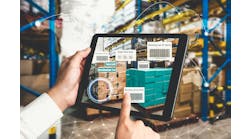This morning, while most of us were asleep, a bakery just outside of Boston was in full production. It's 3:00 a.m., and fresh white bread, wheat bread, raisin bread, rolls and muffins are rolling off the production line, destined for the distribution center, where they will be loaded onto trucks and sent to thousands of supermarkets and outlets across a three state area.
But this bakery is a little different from some. Instead of yawning workers running lift trucks, stacking pallets and loading trucks, a high-speed gantry robot quietly and meticulously sorts and stacks the product according to load and delivery sequence, shifting and moving orders into trucks, and then lifting and moving the remaining staged product to leave an empty floor for a between-shift cleaning, all the while remembering exactly where every single loaf of bread, among several hundred thousand, is located.
Meanwhile, about 800 miles down I-95, workers at a large tire manufacturing facility take a coffee break in the tire curing area. But around the corner, in the distribution center, a robotic “direct ship” system stocks and stages more than 1,000 SKUs of tires, picks truckload after truckload, remembering exactly where each tire is as it stacks, sorts and deploys 55,000 tires a day to precise customer requirements - without ever having seen a person, a pallet or a rack location.
While manual movement of pallets, totes and cartons certainly won't disappear soon, there is a trend toward ever-increasing levels of automation. Add to this a combination of recession economics, DC consolidation, SKU proliferation and the need for absolute end-to-end tracking, and today's robotic systems are looking more and more attractive to material handling engineers. But why now?
Economic Drivers
Preserving profit by cutting costs has resulted in unprecedented consolidation of DCs and interest in automation. New facilities are being scrutinized from end-to-end to take advantage of every advance that will cut costs and increase throughput. If robotic automation can be shown to reduce costs and increase efficiency, then chances are it will play a role in the new DC.
Global competition is also driving efficiency improvements and automation. A 3-5% efficiency improvement is no longer enough. Many manufacturers are now looking for 30% and higher efficiency improvements to stay competitive. Much of this can be found in distribution and transportation.
With DC consolidation, hub and spoke distribution models are being replaced with more centralized and highly automated models. Often these decisions come with the need to combine retail store distribution with direct to consumer e-fulfillment operations. Robotic systems can handle the higher SKU volumes, increased complexity and throughput in a smaller footprint.
In addition, robot order fulfillment systems are designed for optimal loading at the dock, in route-stop sequencing to offset higher transportation costs. This can completely eliminate the need for a satellite DC, enabling direct ship to the customer.
From car parts to pharmaceuticals to food, the ability to track each item all the way through the supply chain is becoming a mandate. Quality control and post-distribution oversight becomes more manageable.
SKUs, SKUs and More SKUs
The growth in product SKUs has placed a huge strain on supply chains. Ten years ago, an average beverage distribution company might have handled 100 SKUs. Today it can be more than 1,000. Couple this with the retailer demand for more variety and lower quantities per SKU, and the result is crowded slot locations and increased pick distance — resulting in inefficient and inaccurate fulfillment.
Migrating from a typical rack-based DC with multiple pick lanes to a gantry robot-based system can help users keep pace with SKU proliferation. It can also reduce the footprint of the material handling system, liberating space for stacking and pallet building. Robots don't need the aisle space, ambient temperature controls or even a break room.
Robotic handling, using today's advanced end effectors, can dramatically reduce damage. Previously this attention to damage control required manual intervention in the supply chain.
Shipment accuracy is also improved. This has both soft and hard metrics. On the soft side, customer satisfaction is related to accurate fill rates of undamaged product. On the hard side, the cost of reverse logistics and the entire return cycle can reduce profitability. Automating the pick process of these SKUs can result in near 100% accuracy
Going hand-in-hand with increased SKUs and rainbow loads is the demand for more frequent delivery of lower volumes, which can strain existing logistics operations. An automated robotic system that does trailer and pallet cubing as well as sequenced loading of LTL and route trucks can improve delivery efficiency and allow consolidation of satellite warehouses.
Finally, labor costs must be factored into the equation. But labor cost reduction due to automation is more complex than a simple reduction of head count. The cost of turnover, training, injuries, theft and inaccuracy can affect the bottom line. Robots can free employees to perform higher value-add jobs, and can reduce injury rates. Higher productivity of the labor force is often an unexpected outcome of automation.
Connecting Islands of Automation
In many ways, robots and the smart controls that drive them represent the “final mile” in material handling automation, the missing link that lets us connect high-speed, sophisticated “islands of automation.” With an improvement in supply chain software and computer processing capability, fully integrated communications enable real time inventory and order tracking for complete visibility into an entire supply chain from factory of origin to the final destination.
Today's solutions feature graphic displays with user-friendly controls based on familiar technology, allowing the operator to easily modify input and output parameters. Libraries of functions are pre-coded, and the old days of manual coding for each application are long gone. This has improved inside-the-warehouse employee-robot industrial relations.
Bill Torrens is director of sales and marketing at RMT Robotics, a Toronto-based company specializing in end-to-end integration of automated warehouse and distribution. He is a mechanical engineer with more than 21 years experience in material handling and robotics system sales.


